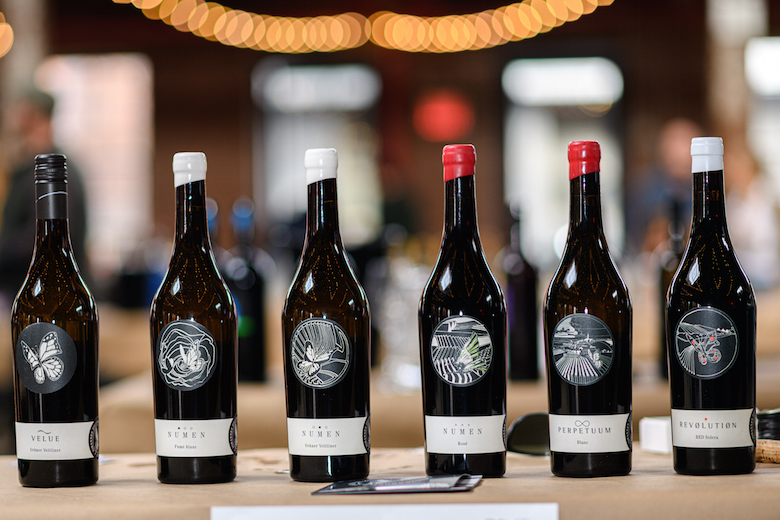
The natural wine fairs and their legions descended upon New York over four days in late October, with wine makers visiting from near and far. Among the locales: Australia, Chile, Italy, Slovakia, France, New Zealand, and yes, New York. Makers, merchants, importers, and fans came out in droves to explore the latest in natural wine, or wine that is made with as little intervention as possible: little to no added sulfites, frequently left unfiltered, with zero synthetic additives and a fairly strict hands-off approach in the cellar and vineyard.
At Brooklyn’s Wild World, held at Berg’n on October 28 and founded by Byron Bates, a former sommelier and co-owner of Goatboy Selections, around 50 exhibitors shared their handcrafted wine, mead, and other fermented beverages, and the day included thoughtful conversation and panels among luminaries in the industry like Jenny Lefcourt (Jenny & Francois Selections), Eric Asimov of the New York Times, and Lee Campbell, influential wine director and sommelier. And before you assume a product that calls itself natural is all peace, love, and understanding, think again. On the second panel of the day (titled OGNY: New York in the 2000’s), panelists recalled being called “the crazy ones” and “[the] lunatic fringe” by the greater wine community, with Campbell notably describing herself and her community as a “weird, fucked up group of curious people.”
Curiosity was in the air at Wild World, with many producers willing to dig deep into their processes and philosophies with anyone who paused to listen. Wine-maker Zack Klug, of Liten Buffel (Niagara, New York) passionately implored a small crowd who had stopped at his booth to taste to consider the environmental implications of farming grapes, natural or otherwise, while pouring healthy tastes of his biodynamic wines (his 2017 Riesling from Seneca Lake’s Shaw Vineyard was a standout). This willingness to question the very thing being sold lent the moment a salon-like experience, and I got the feeling that anything could be questioned, no-stone-unturned style.
Something frequently mentioned in the natural wine community is the effort to knock wine off its pedestal and make it more accessible to the public—rejecting the snobbery commonly seen in classic wine circles and refusing to fall into conventional notions of what wine, or its consumers, should look like. Appropriately, the crowd was deeply diverse across all demographics, ages, and backgrounds. And while on the topic of discovery: I had gone into the fair with the (closeminded) notion that all I wanted to try was wine made from grapes and walked out with a newfound appreciation for mead (or honey wine) thanks to Brooklyn’s own Enlightenment Wines. Curious? Seek out their 2018 ‘Nought’, made from New York State wildflower honey and well water and spontaneously fermented in red wine barrels.
Also taking place in Brooklyn that weekend was Master of Wine Isabelle Legeron’s RAW WINE, now in its fourth year in New York. If Wild World is your unruly little sister who won’t brush her hair before going to school, RAW is the recent college grad who is getting their first professional dye job. This year, the fair was held in the spacious, airy Knockdown Center in Queens, which made the historically packed, somewhat frenetic fair a bit easier to take in. On Monday, the final day of the fair, only a handful of winemakers seemed to be out of product, and gone were the packs of dudes jostling over one another for a taste from the latest star of the natural wine world.
People roamed throughout the space with consideration; leisure and comradery were in the air. Producers happily poured through their entire line-ups, explaining along the way the soil types, geography of the region, and cellar techniques. That is, when they were present. One marked difference between RAW this year and those in years past was the amount of stand-ins for winemakers. Was it because the fair this year fell during what is still harvest for many producers? Was it that they had sent local colleagues to offset the cost of airfare from their respective states or countries? Of course, the wine makers not always being present didn’t affect the quality of the wine (I especially enjoyed a skin contact, or orange, wine from Chateau Lafitte in southwest France, bottled in beautiful stoneware jugs meant to mimic the amphorae the wines are aged in). Still, I did yearn a bit for some of those wild-eyed, off-the-cuff conversations with the producers themselves.
It’s an exciting time to be interested in natural wine, with new fairs, books, podcasts, and columns dedicated to the subject seemingly popping up overnight. When done right, the fairs feel like the urban version of visiting a vineyard, where you get to taste wine directly from the producers and listen to them patiently explain why they do what they do. To listen to a natural winegrower explain their process is to get a better understanding of the politics of natural wine: the struggles with local governments, the rules and conventions and regulations upheld by said governments in order to keep wine tasting the same, the “outcast” status of those that are trying to do something different in major wine regions. And so, you realize that by visiting these fairs you can, of course, further your own wine knowledge and discover some new wine to bring to dinner next time your friend has you over. But by simply being there, you’re also acknowledging the farmers themselves, their dedication, and their work. We’re not going to save the world by visiting wine fairs. But it’s a good place to start paying attention to how we might.



